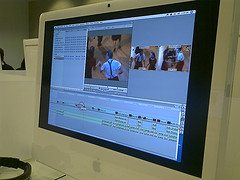Consider this: at many local television stations, reporters cover two or more stories a day and never turn a package. Former news director Geoff Roth, who now teaches at Hofstra University, says the trend toward covering the news with live shots and v/o’s or v/o-sots is not going away. At his last station in Fresno, Calif., reporters were expected to go live at 4 p.m. with a preview and tell the story three more times at 5, 6 and 6:30 using sound and video. No package required. And the network evening newscasts also use fewer traditional packages these days, relying instead on debriefs.
The TV package is definitely not the standard for online video at newspapers, said Hofstra’s Gregg Smith at last week’s Broadcast Education Association conference. A survey he conducted found that 75% of videos on newspaper sites are not narrated and most of those that were came from the AP.
So is there any good reason for young journalists to even learn how to produce a package? “We have to teach beyond it,” Roth said. “We can’t stop teaching the basics, how to write, how to be good storytellers but do it on the fly.” News directors less interested in whether applicants have a finely honed package on their resume reel, he said, and more at whether they can handle a breaking news live shot. “Thinking on the fly, organizing quickly. That’s what will be expected of them.”
Perhaps he’s right. But Peg Achterman of Northwest University, a former television photojournalist, argues that the package has not outlived its usefulness. “We encourage great story thinking when we encourage package production,” she says. “We don’t know where TV will be in 10 years. TV may go back to longer form because shorter form is on the Web. We have to teach them to write visually, communicate visually.”
I’d have to agree with Peg. Even if you work for a newsroom that doesn’t let you write packages, you still have to think about the elements you’d need for a finished product in order to collect the visuals and sound required to tell the story well in some other form. “Package-thinking” teaches shot selection and sequencing. It teaches listening skills and organization. And those are the fundamentals for visual journalists, like footwork and passing for a basketball player.
So what do you think? Is the package passé?










6 Comments
It was a matter of time until someone articulated this. I have noticed the trend. Local stations force reporters into talk-and-point live shots. Network anchors read produced pieces. Network news broadcasts feature many of the same correspondents every night, reading pieces on which producers must have done the bulk of the work. Sometimes, it appears as if those correspondents barely leave the building. And those are the standards to which younger reporters aspire? Is this all the viewing public demands?
It’s another twist on the franchising of America. Years ago, a person could drive from coast to coast, stop in restaurants, and taste the regions. Now, it’s one Burger King or Big Mac or Denny’s Grand Slam after another. Same with television news.
Fifteen years ago, I remember looking at the :25 second reports in radio news, and predicting a similar form molting into television as resources and audiences dwindle. We’re getting there. It’s about money, and serving perceived short public attention spans with story counts.
Not that the package is dead. Nor should it be. Television news does a fine job with immediacy, but I honestly believe the public will rally to well-told, thoughtful pieces, as well. For proof, look to NPR radio any morning or evening.
There is a market. Always has been. No form tells television news better than the traditional package. Fight for it.
Well-told stories will always find an audience – be it in print, on-air or on-line. They need to build suspense, have surprises and a resolution. Just like a good book. Yes, there are few good storytellers in TV today. But those that exist create a unique value for their employer, something viewers craving substance will not find elsewhere. Reporters need to be able to be nimble in live shots, yes. But those that want to stay employed better also be able to develop characters, seek moments and deliver something memorable for their audience – or that audience will go elsewhere.